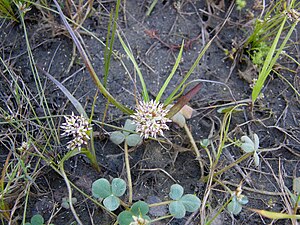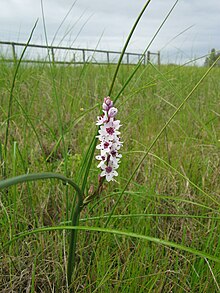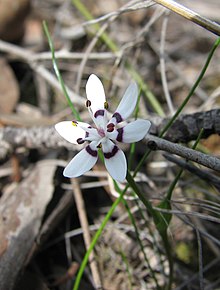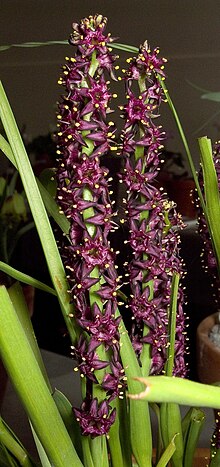Wurmbea
| Wurmbea | ||||||||||||
|---|---|---|---|---|---|---|---|---|---|---|---|---|

|
||||||||||||
| Systematics | ||||||||||||
|
||||||||||||
| Scientific name | ||||||||||||
| Wurmbea | ||||||||||||
| Thunb. |
The plant genus Wurmbea belongs to the timeless family (Colchicaceae). There are around 50 species common in Africa and Australia.
description
Appearance and leaves

Wurmbea species grow as perennial herbaceous plants . As storage organs, these geophytes form underground, egg-shaped to almost spherical sprouts , which are covered by a dark leathery or parchment-like tunic. The above-ground parts of the plant are bare. The upright, unbranched stems are leafy.
The leaves wither in the dry season and are formed again in the rainy season. There are two to four basal and / or alternate, spiral or two-line leaves arranged on the stem , which are divided into leaf sheath and leaf blade. The simple leaf blade is thread-like to ovate, parallel-veined, depending on the species.
Inflorescences and flowers
There are Australian Wurmbea species (for example, Wurmbea dioica , Wurmbea biglandulosa ) that are dioeciously separated-sexed ( dioecious ) to gyno- dioecious ; the flowers of the other Wurmbea species are all hermaphroditic. There may be unbranched inflorescence stems. The sessile flowers are individually or in groups in terminal, spiked inflorescences . There are no bracts .
The flowers, which are often unpleasant-smelling, are radial symmetry and usually tripartite. The usually six, rarely seven or eight, identical bracts are only fused at their base or into a tube and are durable. The bracts stand together in a star to trumpet shape and are upright or bent back in the upper area; when the fruit is ripe they are always bent back. Near the base of the bracts there are one or two nectaries , which are initially darker in color than the bracts, but later have the same color as these. The colors of the bracts range from white to cream to yellow and brown or red; often the edges and tips are colored darker. There are two circles with three stamens each. The free stamens inserted at the base of the bracts or at the top of the flower tube are short and somewhat flat. The mostly dorsifix or rarely basifix, freely movable anthers are bent outwards and open with longitudinal slits. Most three, rarely four carpels are a cylindrical and deeply lobed, upper permanent, usually three, rarely vierkammerigen ovary grown. Many ovules are present in the central-angled placentation . The mostly three short branches of the style are fused at most at their base.
The pollination is effected by insects ( Entomophilie ). In species with cream-colored to brown flowers that smell more or less unpleasant, carrion and houseflies are attracted as pollinators.
Fruits and seeds
The loculicidal and / or septicidal capsule fruits contain many seeds. The more or less spherical seeds have a brown to black seed coat (testa).
Chromosome numbers
The basic chromosome number is x = 11 or 10.
Occurrence and endangerment
The genus Wurmbea has a disjoint area in the southern hemisphere with one species in mountainous regions of tropical Africa and over 20 species each in southern Africa and in temperate to subtropical Australia . Of the approximately 27 Australian species, around 15 each occur in South Australia and Western Australia . In South Africa there are about 22 species, of which about 13 are in the Capensis .
There are species of Wurmbea in summer and winter rain areas . The South African species occur mainly in winter rain areas, but also in the Drakensberg of KwaZulu-Natal and the Eastern Cape .
In South Africa only one species, Wurmbea robusta , is rated as “Critically Endangered”. "Vulnerable" = "endangered" are wormbea capensis , wormbea compacta , wormbea hiemalis and wormbea inusta . The other species occurring in South Africa are rated as “Least Concern” = “not endangered” or there are no evaluations.
In Australia, Wurmbea calcicola and Wurmbea tubulosa are rated as “Endangered” = “critically endangered”.
Systematics




The genus Wurmbea was established in 1781 by Carl Peter Thunberg in Nova Genera Plantarum , Volume 1, p. 18. The type species is Wurmbea capensis Thunb. The genus name Wurmbea honors the German botanist Friedrich von Wurmb . Synonyms for Wurmbea Kunth are: Anguillaria R.Br. nom. illeg., Onixotis Raf. , Skima Raf. , Dipidax Lawson ex Salisb. , Neodregea C.H.Wright .
A revision of the African species outside the Capensis took place in Bertil Nordenstam: The genus Wurmbea in Africa except the Cape region , In: Notes from the Royal Botanic Garden Edinburgh , Volume 36, 1978, pp. 211-233. A revision of the species of Capensis took place in Bertil Nordenstam: The genus wurmbea (Colchicaceae) in the Cape Region , Opera botanica , No. 87, Council for Nordic Publications in Botany, Copenhagen 1986. Revisions of the Australian species were made in Terry D. Macfarlane: A revision of Wurmbea (Liliaceae) in Australia , In: Brunonia , Volume 3, Issue 2, 1980, pp. 145-208 , Robert J. Bates: The species of Wurmbea (Liliaceae) in South Australia , In: Journal of the Adelaide Botanic Gardens , Volume 16, 1995, pp. 33-54. and Robert J. Bates: A review of South Australian Wurmbea (Colchicaceae-Liliaceae): keys, new taxa and combinations, and notes , In: Journal of the Adelaide Botanic Gardens , Volume 21, 2007, pp. 75-81. In 1980 Macfarlane placed the species of the Australian genus Anguillaria in the genus Wurmbea . The two species of the genus Onixotis and the only species of the genus Neodregea were John C. Manning and Annika Vinnersten in A new classification of Colchicaceae , In: taxon , Volume 56, 2007, pp 177 in the genre Wurmbea asked.
The genus Wurmbea belongs to the tribe Anguillarieae within the family Colchicaceae ; it was formerly part of the Liliaceae family.
There are around 50 species of Wurmbea (here with their distribution):
- Wurmbea angustifolia B.Nord. : It occurs in the South African provinces of Eastern Cape , Free State and KwaZulu-Natal and in Zimbabwe.
- Wurmbea australis (RJBates) RJBates : It occurs in South Australia .
- Wurmbea biglandulosa (R.Br.) TDMacfarl. : It occurs in two subspecies from southeastern Queensland to southeastern Australia.
- Wurmbea burttii B.Nord. : It occurs in Lesotho and KwaZulu-Natal.
- Wurmbea calcicola T.D. Macfarl. : It occurs in Western Australia and is rated as "Endangered".
- Wurmbea capensis Thunb. : It thrives on stony slopes in the Western Cape and is rated as "Vulnerable" = "endangered".
- Wurmbea centralis T.D. Macfarl. : It is only known from four locations in central and southern Australia.
- Wurmbea cernua T.D. Macfarl. : It occurs in southern Western Australia.
- Wurmbea citrina (RJBates) RJBates : The range extends from South Australia to New South Wales .
- Wurmbea compacta B.Nord. : It thrives on stony slopes only in the Montagu Mountains in the Western Cape and is rated as "Vulnerable" = "endangered".
- Wurmbea decumbens R.J.Bates : It occurs in South Australia.
- Wurmbea densiflora (Benth.) TDMacfarl. : It occurs in Western Australia.
- Wurmbea deserticola T.D. Macfarl. : It occurs in the mountain ranges of central and western Australia.
- Wurmbea dilatata T.D. Macfarl. : It occurs in western Western Australia.
- Wurmbea dioica (R.Br.) F.Muell. : There are several subspecies of this diocesan species that occur in Western Australia, South Australia, Queensland , New South Wales, Australian Capital Territory , Victoria and Tasmania .
- Wurmbea dolichantha B.Nord. : It occurs on sand and clay in the North Cape and Western Cape.
- Wurmbea drummondii Benth. : It occurs in southwestern Australia.
- Wurmbea elatior B.Nord. : It occurs in the Eastern Cape.
- Wurmbea elongata B.Nord. : It thrives on rocky sandstone slopes in the Eastern Cape and Western Cape.
- Wurmbea fluviatilis T.D. Macfarl. & ALCase : It occurs in northwestern Western Australia.
- Wurmbea glassii (CHWright) JCManning & Vinn. : It occurs only in the Eastern and Western Cape.
- Wurmbea graniticola T.D. Macfarl. : It occurs in southwestern Australia.
- Wurmbea hiemalis B.Nord. : It occurs in the Western Cape on moist, sandy slopes on the Cape Peninsula and is rated as "Vulnerable" = "endangered".
- Wurmbea inflata T.D. Macfarl. & ALCase : It occurs in Western Australia.
- Wurmbea inframediana T.D. Macfarl . : It occurs in Western Australia.
- Wurmbea inusta (Baker) B.Nord. : It occurs in the Western Cape on damp, heavy soils and is rated as "Vulnerable" = "endangered".
- Wurmbea kraussii Baker : It occurs in the Eastern Cape.
- Wurmbea latifolia T.D. Macfarl. : It occurs in two subspecies in South Australia, New South Wales and Victoria; in Tasmania the stocks may have run out.
- Wurmbea marginata (Desr.) B.Nord. : It occurs in the Western Cape on flat, moist soils.
- Wormbea minima B.Nord. : It occurs in the Western Cape.
- Wurmbea monantha (Endl.) TDMacfarl. : It occurs in western and southwestern Western Australia.
- Wurmbea monopetala (L. f.) B.Nord. : It thrives on sandstone and granite slopes in the Western Cape.
- Wurmbea murchisoniana T.D. Macfarl . : It occurs in western Western Australia.
- Wurmbea nilpinna R.J.Bates : This rare endemic is only found in the Davenport Range at Nilpinna Station in the Lake Eyre region of South Australia . It does not bloom in everyone between June and September depending on the rainfall.
- Wurmbea novae-zelandiae (Hook.f. ex Kirk) Lekhak, Survesw. & SRYadav (Syn .: Anguillaria novae-zelandiae Hook.f. ex Kirk , Iphigenia novae-zelandiae (Hook.f. ex Kirk) Baker ): It occurs in New Zealand from southern Canterbury to northern Otago .
- Wurmbea odorata T.D. Macfarl. : It occurs in Western Australia.
- Wurmbea punctata (L.) JCManning & Vinn. : It occurs in the North Cape and Western Cape.
- Wurmbea pusilla E. Phillips : It occurs in Lesotho and KwaZulu-Natal.
- Wurmbea pygmaea (Endl.) Benth. : It occurs in west-southwest Western Australia .
- Wurmbea recurva B.Nord. : It occurs in the Western Cape.
- Wurmbea robusta B.Nord. : This endangered species is only found in Swartland Shale Renosterveld in the Western Cape. It is rated as "Critically Endangered".
- Wurmbea saccata T.D. Macfarl. & SJvan Leeuwen : It occurs in Western Australia.
- Wurmbea sinora T.D. Macfarl. : It occurs in southwest and southern Western Australia.
- Wurmbea spicata (Burm. F.) T.Durand & Schinz : It occurs in two varieties in the North Cape and Western Cape.
- Wurmbea stellata R.J.Bates : It occurs in the Gawler Ranges in South Australia.
- Wurmbea stricta (Burm. F.) JCManning & Vinn. : It occurs in humid locations in the Western Cape and southern Namaqualand .
- Wurmbea tenella (Endl.) Benth. : It occurs in Western Australia.
- Wurmbea tenuis (Hook. F.) Baker : It occurs with four subspecies in tropical and southern Africa.
- Wurmbea tubulosa Benth. : It occurs in Western Australia and is rated as "Endangered".
- Wurmbea uniflora (R.Br.) TDMacfarl. : There are fewer than 200 specimens of this rare species in two locations near Adelaide .
- Wurmbea variabilis B.Nord. : It thrives on sandy slopes in the Northern, Eastern and Western Cape.
There are some natural hybrids .
use
Nothing is known about its use.
Name declaration
The generic name honors the German-Dutch merchant, colonial administrator and botanist Christoph Carl Friedrich von Wurmb (Fredrick Baron van Wurmbe) (1742 - 1781).
literature
- GJ Harden: Entry in the New South Wales Flora Online . (Sections Description, Distribution and Systematics)
- J. Gathe & Leslie Watson, 2008: Entry in the Western Australian Flora . (Section description)
- John C. Manning, Peter Goldblatt & Dee Snijman: The color encyclopedia of Cape bulbs , Timber Press, Portland and Cambridge, 2002. ISBN 0-88192-547-0 : Wurmbea on pp. 409-412 (sections description, distribution and systematics )
- Robert J. Bates: A review of South Australian Wurmbea (Colchicaceae-Liliaceae): keys, new taxa and combinations, and notes , In: Journal of the Adelaide Botanic Gardens , Volume 21, 2007, pp. 75-81. (Sections distribution and systematics)
- Andrea L. Case, Sean W. Graham, Terry D. Macfarlane & Spencer CH Barret: A phylogenetic study of evolutionary transitions in sexual systems in Australian Wurmbea (Colchicaceae) , In: International Journal of Plant Sciences , Volume 169, Issue 1, 2008 , Pp. 141–156: full text PDF.
- G. Vaughton & M. Ramsey: Gender plasticity and sexual system stability in Wurmbea , In: Annals of Botany , Volume 109, Issue 3, 2012, p. 521.
- Spencer CH Barrett & Andrea L. Case: The ecology and evolution of gender strategies in plants: the example of Australian Wurmbea (Colchicaceae) , In: Australian Journal of Botany , Volume 54, 2006, pp. 417-433: Volltext-PDF.
Individual evidence
- ↑ a b c d e f g h i j k l m n o p q r s t u v w x y z aa ab ac ad ae af ag ah Rafaël Govaerts (Ed.): Wurmbea. In: World Checklist of Selected Plant Families (WCSP) - The Board of Trustees of the Royal Botanic Gardens, Kew . Retrieved June 28, 2018.
- ↑ a b c d e GJ Harden: Entry in the New South Wales Flora Online . Retrieved March 19, 2013.
- ↑ a b c d e f g h i j k John C. Manning, Peter Goldblatt & Dee Snijman: The color encyclopedia of Cape bulbs , Timber Press, Portland and Cambridge, 2002. ISBN 0-88192-547-0 , Wurmbea pages 409-412
- ↑ a b c d e J. Gathe & Leslie Watson, 2008: Entry in the Western Australian Flora . Retrieved March 19, 2013.
- ↑ a b c Spencer CH Barrett & Andrea L. Case: The ecology and evolution of gender strategies in plants: the example of Australian Wurmbea (Colchicaceae) , In: Australian Journal of Botany , Volume 54, 2006, pp. 417-433: Full text PDF.
- ↑ a b c d e f g h i j k l m n o p q r s t u v D. Raimondo, L. von Staden, W. Foden, JE Victor, NA Helme, RC Turner, DA Kamundi & PA Manyama , 2009: Entry on the Red List of South African Plants of the South African National Biodiversity Institute = SANBI . Retrieved March 20, 2013.
- ↑ a b c EPBC Act List of Threatened Flora . Retrieved March 19, 2013.
- ↑ Wurmbea at Tropicos.org. Missouri Botanical Garden, St. Louis, accessed March 19, 2013.
- ^ A b Wurmbea in the Germplasm Resources Information Network (GRIN), USDA , ARS , National Genetic Resources Program. National Germplasm Resources Laboratory, Beltsville, Maryland. Retrieved March 19, 2013.
- ↑ a b Entry in Australian Plant Name Index = APNI . Retrieved March 20, 2013.
